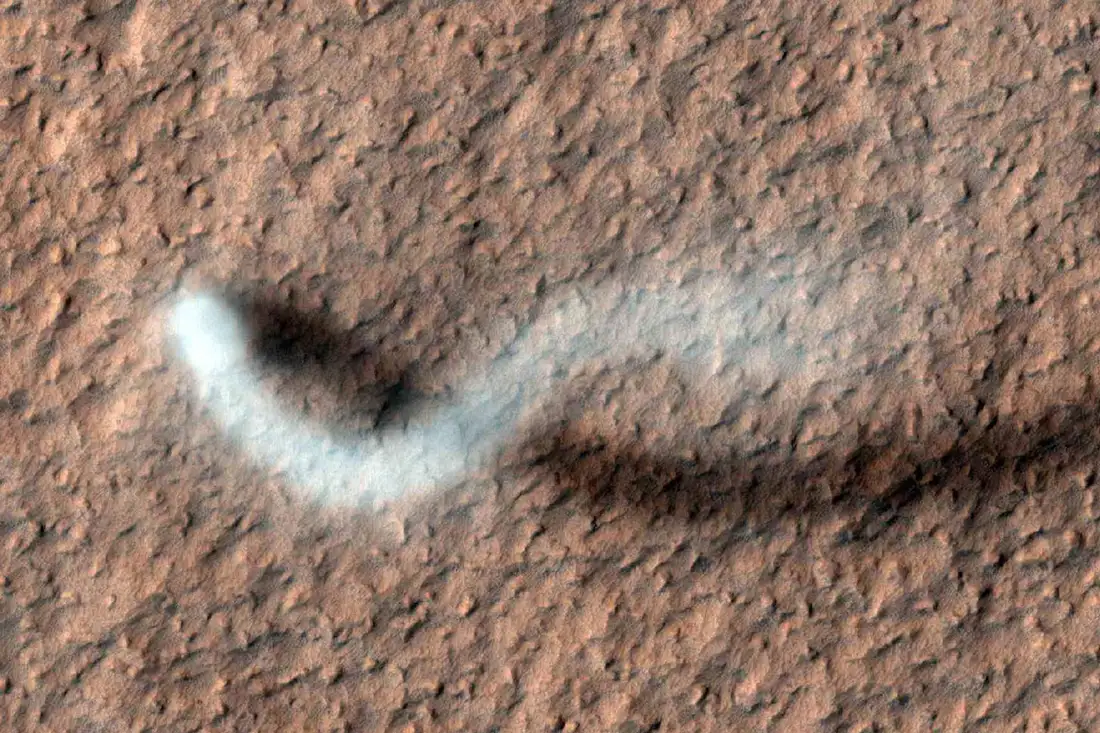Science
Mars Dust Devils Exceed Expectations with Powerful Winds

A recent study reveals that dust devils on Mars are much more powerful than previously believed. Researchers found that these whirlwinds can reach wind speeds of up to 44 m/s (approximately 160 km/h or 100 mph), a significant increase compared to earlier estimates. The findings, published on October 8, 2025, in the journal Science Advances, were led by Dr. Valentin Bickel from the University of Bern, along with a team of international scientists.
Understanding Dust Devils on Mars
Dust devils are common on Mars, much like on Earth. These short-lived whirlwinds form due to surface heating, leading to changes in air pressure that create a vertical column of wind. As this column pulls in surrounding air, it transforms into a vortex that lifts dust from the Martian surface. Despite Mars’ thin atmosphere—less than 1% of Earth’s—lower gravity allows these dust devils to grow larger than those on our planet.
The research team, which included experts from the Centre for Earth, Planetary, Space and Astronomical Research (CEPSAR) at the Open University and the Institute of Planetary Research (IPR) at the German Aerospace Center (DLR), utilized advanced machine learning techniques to analyze images of Mars taken by the ExoMars Trace Gas Orbiter (TGO) and the Mars Express mission.
Dr. Bickel highlighted the significance of their approach: “Using a state-of-the-art deep learning method, we identified dust devils in over 50,000 satellite images. Our findings are grounded in data from European Mars exploration, providing a comprehensive view of these phenomena.”
Implications for Martian Weather and Future Missions
The research not only sheds light on the dynamics of Martian winds but also has broader implications for understanding the planet’s climate and weather patterns. The stronger winds identified in this study could significantly contribute to dust uplift, impacting Martian weather and environmental conditions.
Previous measures indicated that winds on Mars typically remained below 50 km/h (approximately 31 mph100 km/h (about 62 mph). The new data suggests that dust devils play a crucial role in the distribution of dust across the Martian landscape.
“A better understanding of the wind conditions on Mars is crucial for the planning and execution of future landed missions,” said Daniela Tirsch, a co-author from the Institute of Space Research at DLR. “With the help of the new findings on wind dynamics, we can model the Martian atmosphere and associated surface processes more precisely.”
These insights will be vital as space agencies plan future missions to Mars, including potential crewed expeditions anticipated in the coming decades. By improving climate models, researchers can assess risks to equipment and crews, ensuring safer and more efficient missions.
The team intends to expand their research by coordinating additional observations from the CaSSIS and HRSC imaging systems. This ongoing investigation aims to refine their understanding of dust devils and their impact on Martian weather, providing invaluable data for future explorations of the Red Planet.
For further details, refer to the full study published in Science Advances and updates from the University of Bern.
-

 Science4 weeks ago
Science4 weeks agoALMA Discovers Companion Orbiting Giant Red Star π 1 Gruis
-

 Top Stories2 months ago
Top Stories2 months agoNew ‘Star Trek: Voyager’ Game Demo Released, Players Test Limits
-

 Politics2 months ago
Politics2 months agoSEVENTEEN’s Mingyu Faces Backlash Over Alcohol Incident at Concert
-

 World2 months ago
World2 months agoGlobal Air Forces Ranked by Annual Defense Budgets in 2025
-

 World2 months ago
World2 months agoMass Production of F-35 Fighter Jet Drives Down Costs
-

 World2 months ago
World2 months agoElectrification Challenges Demand Advanced Multiphysics Modeling
-

 Business2 months ago
Business2 months agoGold Investment Surge: Top Mutual Funds and ETF Alternatives
-

 Science2 months ago
Science2 months agoTime Crystals Revolutionize Quantum Computing Potential
-

 Top Stories2 months ago
Top Stories2 months agoDirecTV to Launch AI-Driven Ads with User Likenesses in 2026
-

 Entertainment2 months ago
Entertainment2 months agoFreeport Art Gallery Transforms Waste into Creative Masterpieces
-

 Business2 months ago
Business2 months agoUS Government Denies Coal Lease Bid, Impacting Industry Revival Efforts
-

 Health2 months ago
Health2 months agoGavin Newsom Critiques Trump’s Health and National Guard Plans









